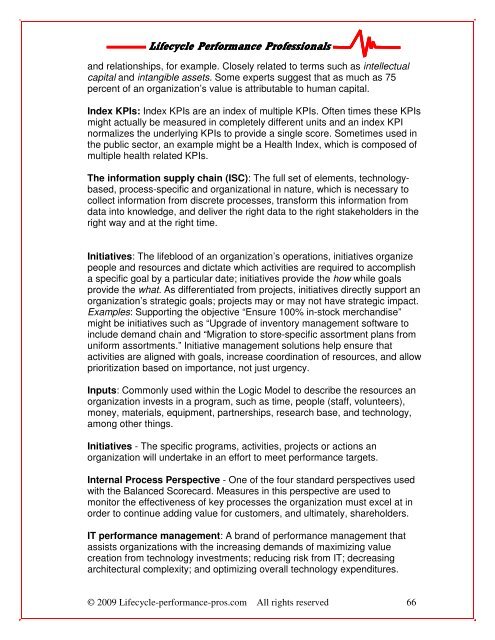Download the Performance Management Fundamentals Guide
Download the Performance Management Fundamentals Guide
Download the Performance Management Fundamentals Guide
You also want an ePaper? Increase the reach of your titles
YUMPU automatically turns print PDFs into web optimized ePapers that Google loves.
Lifecycle Lifecycle <strong>Performance</strong> <strong>Performance</strong> Professionals<br />
Professionals<br />
and relationships, for example. Closely related to terms such as intellectual<br />
capital and intangible assets. Some experts suggest that as much as 75<br />
percent of an organization’s value is attributable to human capital.<br />
Index KPIs: Index KPIs are an index of multiple KPIs. Often times <strong>the</strong>se KPIs<br />
might actually be measured in completely different units and an index KPI<br />
normalizes <strong>the</strong> underlying KPIs to provide a single score. Sometimes used in<br />
<strong>the</strong> public sector, an example might be a Health Index, which is composed of<br />
multiple health related KPIs.<br />
The information supply chain (ISC): The full set of elements, technologybased,<br />
process-specific and organizational in nature, which is necessary to<br />
collect information from discrete processes, transform this information from<br />
data into knowledge, and deliver <strong>the</strong> right data to <strong>the</strong> right stakeholders in <strong>the</strong><br />
right way and at <strong>the</strong> right time.<br />
Initiatives: The lifeblood of an organization’s operations, initiatives organize<br />
people and resources and dictate which activities are required to accomplish<br />
a specific goal by a particular date; initiatives provide <strong>the</strong> how while goals<br />
provide <strong>the</strong> what. As differentiated from projects, initiatives directly support an<br />
organization’s strategic goals; projects may or may not have strategic impact.<br />
Examples: Supporting <strong>the</strong> objective “Ensure 100% in-stock merchandise”<br />
might be initiatives such as “Upgrade of inventory management software to<br />
include demand chain and “Migration to store-specific assortment plans from<br />
uniform assortments.” Initiative management solutions help ensure that<br />
activities are aligned with goals, increase coordination of resources, and allow<br />
prioritization based on importance, not just urgency.<br />
Inputs: Commonly used within <strong>the</strong> Logic Model to describe <strong>the</strong> resources an<br />
organization invests in a program, such as time, people (staff, volunteers),<br />
money, materials, equipment, partnerships, research base, and technology,<br />
among o<strong>the</strong>r things.<br />
Initiatives - The specific programs, activities, projects or actions an<br />
organization will undertake in an effort to meet performance targets.<br />
Internal Process Perspective - One of <strong>the</strong> four standard perspectives used<br />
with <strong>the</strong> Balanced Scorecard. Measures in this perspective are used to<br />
monitor <strong>the</strong> effectiveness of key processes <strong>the</strong> organization must excel at in<br />
order to continue adding value for customers, and ultimately, shareholders.<br />
IT performance management: A brand of performance management that<br />
assists organizations with <strong>the</strong> increasing demands of maximizing value<br />
creation from technology investments; reducing risk from IT; decreasing<br />
architectural complexity; and optimizing overall technology expenditures.<br />
© 2009 Lifecycle-performance-pros.com All rights reserved 66










